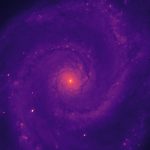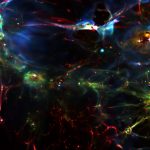The optical lenses for the Dark Energy Spectroscopic Instrument have seen their first light. Fermilab contributed key components to DESI, including the corrector barrel and its support structures, along with vital software that ensures the instrument’s 5,000 robotic positioners are precisely aligned with their celestial targets.
dark energy
For The New York Times, Feb. 25, 2019: Axions? Phantom energy? Astrophysicists scramble to patch a hole in the universe, rewriting cosmic history in the process. Fermilab scientist Josh Frieman is quoted in this article.
With the warmth of holiday cheer in the air, some physicists decided to hit the pub after a conference in December 2014 and do what many physicists tend to do after work: keep talking about physics. That evening’s topic of conversation: dark energy particles. The chat would lead to a new line of investigation at the Large Hadron Collider at CERN. Every second, the universe grows a little bigger. Scientists are using the LHC to try to find out why.
From Nature Reviews Physics, Jan. 28, 2019: The Dark Energy Survey completed its six-year-mission to map more than 300 million distant galaxies; however, an equally arduous task — analyzing the acquired 50 terabytes of data with a view to understanding the expansion of the universe — is just beginning.
From APS’s Physics, Jan. 29, 2019: On Jan. 9, a handful of researchers with the Dark Energy Survey — one of the most ambitious attempts to probe the dynamics of the universe’s expansion — headed to the control room of Chile’s Blanco Telescope. For one last time, they opened the white telescope’s dome. From their perch overlooking the red Andean Mountains, they set up for a night of observing the southern sky.
From WDCB’s First Light, Jan. 20, 2019: This WDCB interview features Fermilab scientists Brenna Flaugher and Tom Diehl talking about the final nights of the Dark Energy Survey.
From Sinc, Jan. 15, 2019: Tras seis años captando millones de galaxias con una cámara del telescopio Blanco, la colaboración científica Dark Energy Survey ha completado el cartografiado de un octavo del cielo con un detalle sin precedentes. Los resultados ya han servido para publicar más de 200 artículos científicos, pero se esperan muchos más, con el objetivo puesto en descubrir la naturaleza de la misteriosa energía oscura.
From 365 Days of Astronomy, Jan. 12, 2019: The Dark Energy Survey is the subject of this 30-minute podcast. DES started in 2013 to map dark energy over 5000 square degrees of sky. It used a massive 500-megapixel camera attached to the Blanco Telescope at Cerro Tololo Inter-American Observatory in Chile. The survey concluded on Jan. 9, 2019, with its last night of observing. At the American Astronomical Society meeting in Seattle, they conferenced with observers on the last night. Listen to the conversation at the end of this journey.
From University of Chicago, Jan. 9, 2019: After scanning about a quarter of the southern skies over 800 nights, the Dark Energy Survey finished taking data on Jan. 9. It ends as one of the most sensitive and comprehensive surveys of its kind, recording data from more than 300 million distant galaxies. Fermilab, an affiliate of the University of Chicago, served as lead laboratory on the survey, which included more than 400 scientists and 26 institutions.
From, El Dia, Jan. 9, 2019: El trabajo fue po astrofísicos del proyecto Dark Energy Survey, tras seis años de observación en los que acumularon información de más de 300 millones de galaxias lejanas.


